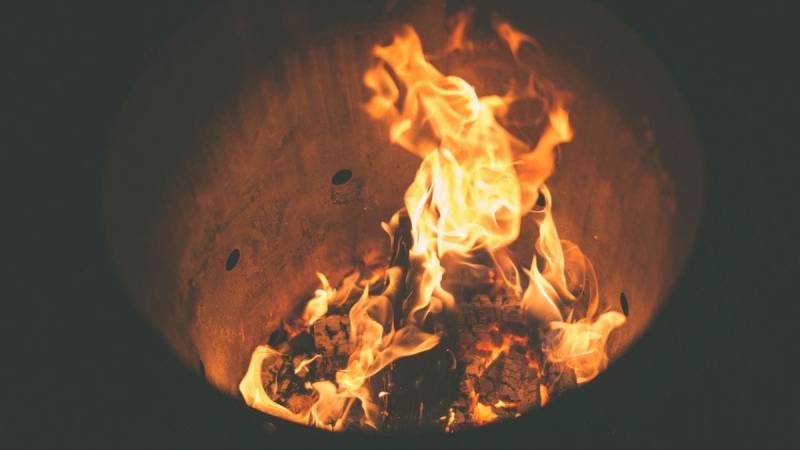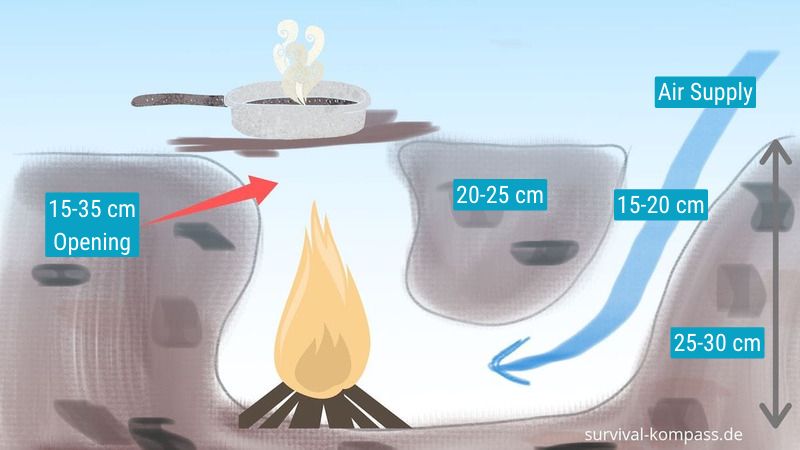
What is a tunnel pit fire (Dakota fire hole)
👉 The key facts from this guide
- A tunnel pit fire, also known as a Dakota fire, is an efficient way to start a fire. It consists of two pits connected by a tunnel. One pit is for the fire, the other for fresh air supply.
- The advantages of a tunnel pit fire are that it is almost invisible, protected from wind, and can also be fueled with green or moist wood. It is also well-suited for cooking.
- The disadvantages are that it requires a lot of fuel and is not well-suited for providing warmth.
- To build a tunnel pit fire, you dig two holes and connect them with a tunnel. The fire pit has a diameter of approximately 30 cm and the air hole has a diameter of approximately 20 cm. The pits should be 15–30 centimeters deep.
- The tunnel pit fire was practiced by the Dakota indigenous people and is therefore also known as a "Dakota fire".
A fire that is protected from the wind and also hidden?
Sounds good, right? Then learn now what a tunnel fire is.
What is a tunnel fire?
A tunnel pit fire is a fire in a pit that is connected to a second pit by a tunnel. The first pit is for the fire and the second pit is for fresh air supply. Since fire needs oxygen to burn, a tunnel pit fire is particularly efficient because oxygen is supplied directly to the fire from below through the second tunnel.
This infographic illustrates the principle:

The tunnel pit fire is also called "Dakota fire" or "Dakota fire hole". The term comes from the North American prairie. This type of fire was practiced by the Dakota Indians.
Structure of the Tunnel Fire
Dig two holes. The fire pit has a diameter of about 30 cm and the hole for air is about 20 cm.
The pits should be 15–30 centimeters deep.
Then connect the pits with a tunnel.
Ideally, you should flatten the air hole so that more oxygen can flow into the tunnel.
The Benefits of Tunnel Kiln Firing
The tunnel pit fire has some excellent advantages.
Almost Invisible
Just Bushcrafters and survivalists often want to remain undetected.
The tunnel pit fire is well-suited for this purpose, as the flame is hidden in the ground. The fire is therefore almost invisible.
Sure, you have to make sure it doesn't smoke. But since you know how to start a proper fire, you'll avoid that.
Wind-protected
Furthermore, a Dakota fire is protected from wind. This allows you to make a campfire even when it's very windy.
Moist Fuel
The tunnel stove can also be heated with green or damp wood. Even less good wood burns great with it. In addition, the draft generates additional heat.
As a cooking fire
With the Tunnel Pit Fire, you can cook wonderfully. Simply place your pot on top or lay your grill over it.
The Disadvantages
Since the fire burns perfectly, you also need a lot of fuel. So if you only have limited wood available, the tunnel pit fire is not a good choice.
Unfortunately, the tunnel pit fire is not a good choice for heating. There are other good construction forms that I detail in my e-book.
Reading Tips
As a complement, I would like to recommend the following articles from me:
And of course, my book "The Fire Primer" should not be missing from the collection. I have packed all my experience with fire into it.
Have you ever built a tunnel fire pit?
Or do you now plan to test it?
Write your opinion in the comments!

Sources for the guide
https://de.wikipedia.org/wiki/Lagerfeuer

Author of the guide
Martin Gebhardt
Hey, I'm Martin. On my blog, you will learn the basics and numerous details about living in the wild. I think survival, bushcraft and the good life in nature are the keys to happiness. Find me here on Instagram or on YouTube. You can find more about my mission on the About Me page.
Was this guide helpful?
31 people found this guide helpful.
4.88 out of 5 points (32 Ratings)
Comments (0)
This post may contain affiliate links. So if you click on the links and make a purchase, I will receive a small commission at no additional cost to you. Click here, to learn more about it.


